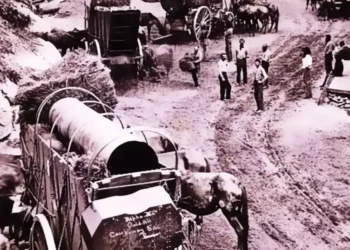El Dorado County (Oct 13, 2024) – “To Old Hangtown or Bust: Pilgrimage of J. M. Studebaker to the Place Where He Made His First Stake and Got His Start in Life” is a captivating glimpse into the journey of John M. Studebaker, a pioneer of American industry, to the iconic gold rush town of Hangtown, now known as Placerville, California. This historical narrative, with its 52 pages and a freshly indexed reprint, offers an invaluable resource for both historians and enthusiasts of the gold rush era. It not only serves as a personal reflection on Studebaker’s formative years but also chronicles the experiences of an entire generation who shaped the American West.
The book was originally prepared following Studebaker’s nostalgic return to Hangtown in April 1912, decades after he first arrived as a young man chasing dreams of fortune. By this time, he was president of the Studebaker Corporation, a company synonymous with high-quality wagons and later, automobiles. His visit was more than a simple reunion—it was a chance to reconnect with old friends and reminisce about the formative days when fortune seekers swarmed the California hills, and true wealth came from innovation and hard work.
This account preserves the rich oral histories shared during Studebaker’s visit, offering readers a firsthand look at life during the gold rush. From tales of camaraderie to the struggles of young prospectors, the book encapsulates the spirit of the era. It is especially notable for highlighting the bonds forged in the chaos of the gold rush—a time when lasting friendships could be as valuable as gold itself.
Studebaker’s personal story stands as a testament to the power of adaptation. Arriving in Hangtown as a young man in his twenties, he initially sought gold like many others. But it was his keen observation and resourcefulness that truly set him apart. Seeing a demand among miners for durable tools, he shifted his focus to blacksmithing, and soon, the manufacture of wheelbarrows became his claim to fortune. This humble beginning in the rugged hills of California laid the foundation for what would become the Studebaker Corporation, a giant in the production of wagons and, eventually, automobiles.
The book details his return to the place where he made his “first stake,” a pilgrimage not just to relive his youth, but to reflect on the profound role Hangtown played in shaping his path to success. It highlights the essence of the American entrepreneurial spirit—one driven not merely by striking it rich through gold, but by meeting the practical needs of others and working with tenacity.
In many ways, Studebaker’s journey symbolizes the broader narrative of the gold rush. While few struck it rich in the mines, those who adapted and filled the needs of the growing population were the ones who found lasting success. His rise from a wheelbarrow maker in a dusty mining town to the head of a major corporation illustrates the ingenuity and resilience that characterized many of the era’s greatest achievements.
To Old Hangtown or Bust serves as both a personal memoir and a broader historical reflection, shedding light on the people who built their fortunes not from the ground, but through their own hands and minds. The story of John M. Studebaker, from a blacksmith in Hangtown to an industrial titan, is a fitting metaphor for the American Dream itself.
John M. Studebaker’s success is a classic story of entrepreneurial ingenuity and resilience. His journey from a blacksmith in the California Gold Rush to the head of one of the largest wagon and automobile companies in America is both inspiring and instructive.
Early Life and Gold Rush Experience
Born in 1833 in Gettysburg, Pennsylvania, John M. Studebaker was part of a family of wagon makers. As a young man, he joined the California Gold Rush in 1853, hoping to strike it rich. However, instead of finding success as a miner, Studebaker took a different route—he realized that miners needed reliable tools and equipment. So, instead of digging for gold himself, he made wheelbarrows and wagons for the miners, supplying a crucial service to those seeking their fortunes. His work was of such quality that it quickly gained a reputation, and it laid the foundation for his future success.
Formation of the Studebaker Corporation
After his time in California, Studebaker returned to his family’s blacksmith and wagon-making business in South Bend, Indiana. In 1852, the Studebaker brothers, including John, Henry, and Clem, founded the Studebaker Brothers Manufacturing Company. At first, the company specialized in producing horse-drawn wagons and carriages, which were in high demand due to westward expansion, agriculture, and military contracts.
During the American Civil War, the Studebaker company became a major supplier of wagons for the Union Army, solidifying their reputation for durability and quality. This helped the company grow rapidly, and by the late 19th century, Studebaker was the largest producer of wagons in the world. The famous “Conestoga wagons,” used by pioneers heading west, were often made by Studebaker.
Entry into the Automobile Industry
As the transportation industry began to shift from horse-drawn vehicles to automobiles, Studebaker recognized the potential of this new technology. In 1902, the company began manufacturing electric vehicles and later transitioned to gasoline-powered automobiles. This forward-thinking move allowed Studebaker to become a major player in the emerging automobile industry.
Studebaker’s cars were known for their quality and craftsmanship, carrying over the company’s reputation for durable wagons. Under John M. Studebaker’s leadership, the company maintained its commitment to innovation, becoming one of the first companies to mass-produce automobiles.
Studebaker’s Legacy
By the time of John M. Studebaker’s death in 1917, the company had firmly established itself as a giant in both the wagon and automobile markets. The Studebaker brand became synonymous with innovation and reliability. Although the company eventually faced challenges in the highly competitive auto industry, Studebaker vehicles, including models like the Champion, Commander, and Avanti, are still fondly remembered for their design and engineering.
John M. Studebaker’s life epitomizes the American Dream—starting from modest beginnings and using skill, vision, and hard work to build a legacy that had a lasting impact on American industry. His success is not only a personal triumph but also a story of how understanding the needs of others and adapting to new technological trends can lead to lasting achievement.










